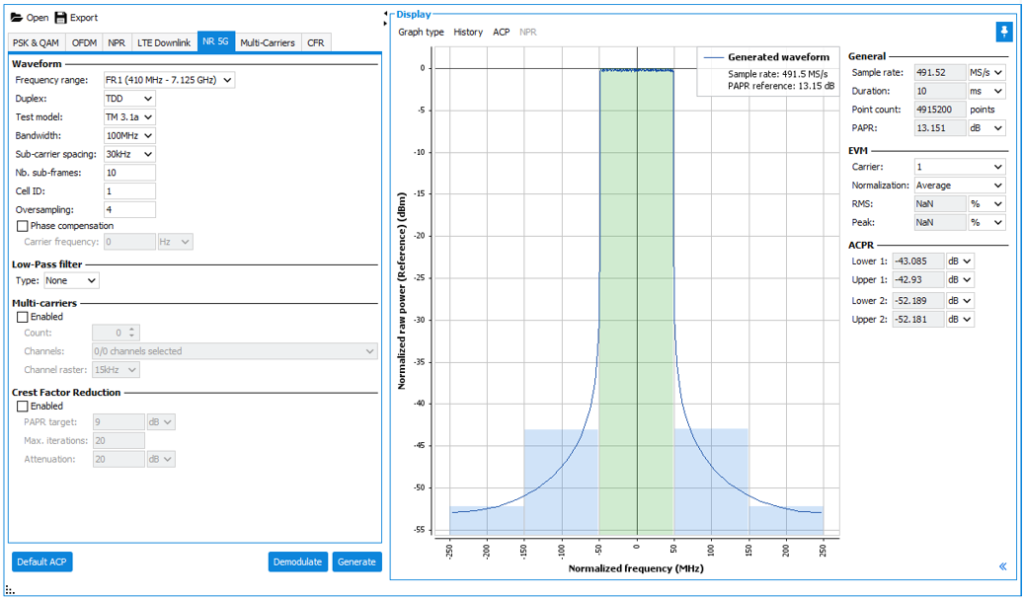AMCAD Engineering has announced the release of version 1.6 of IQSTAR, the most advanced RF Circuit Characterization Software.
This major release includes new modules and features to address the industry’s additional applications and measurement requirements. It also showcases enhancements of the capabilities of the existing modules to increase user experience satisfaction.
The growing popularity of IQSTAR brings its share of customer requests to include new software capabilities, allowing them to characterize their power amplifiers. The last release of IQSTAR includes three new modules:
IQSTAR 1.6 Main New Features and Software options
To improve the test engineer’s measurement efficiency and to provide an appropriate tool for a thorough analysis of the amplifier performances, multiple features were added to the IQSTAR modules.
- LTE and NR 5G waveform generator
In IQSTAR 1.6, the waveform generator was updated with new functionalities to generate LTE or NR 5G signal and adjust its setting to reflect the user-defined signal. The signal can then be exported to a file or directly uploaded to a vector signal generator.
The waveform generator user interface includes new features to enhance the user experience. For example, activating the “History” of the waveforms is now possible to better display the differences between different signals generated. As this feature can be memory-demanding, clearing the history and deactivating it is possible. It is also possible to display the signal in modes like spectrum, CCDF, Abs(IQ) and Phase(IQ).
- LTE and NR 5G Demodulation
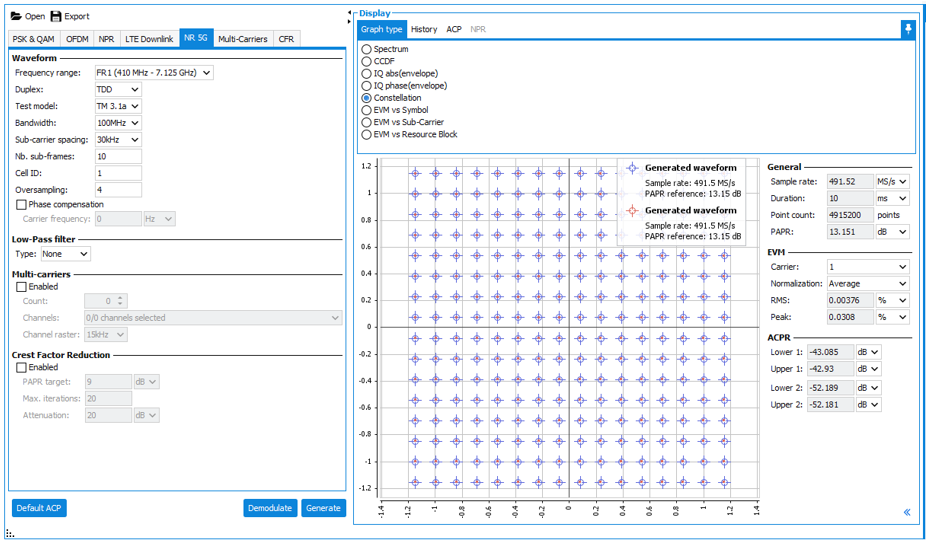
One major improvement of version 1.6 of IQSTAR is the demodulation capabilities added to the characterization flow. The demodulation is done directly in IQSTAR, allowing the use of any combination of vector signal generator and signal analyzer from different brands without any modulation personality options. Using only a radio unit like the AMD ZCU670 RF SoC or AMCAD IQMASTER 6400 Vector Signal Transceiver instrument, it is also possible to characterize the amplifier, including the EVM measurements.
With these new features, the characterization of the PA will include the EVM calculation and the constellation display.
- Multi-carrier signal generation and demodulation (LTE and NR 5G waveforms)
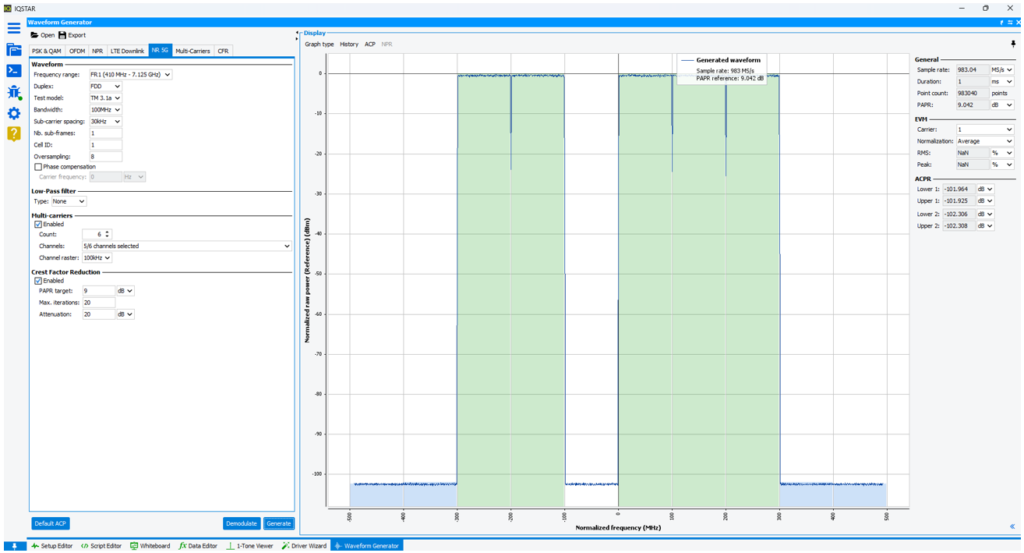
As a direct consequence of the new features described above, the new release of IQSTAR allows the generation and demodulation of multi-carrier signals.
Using multi-carrier signals for characterizing power amplifiers is essential to ensure that these amplifiers can handle the complexity of real-world communication signals. It helps evaluate linearity, efficiency, and the generation of unwanted distortion products, making it a critical step in designing and testing RF and wireless communication systems. IQSTAR allows the calculation of EVM for each of the carriers independently.
- New waveform generation and demodulation module for LTE signal (WFG100-11 Option)
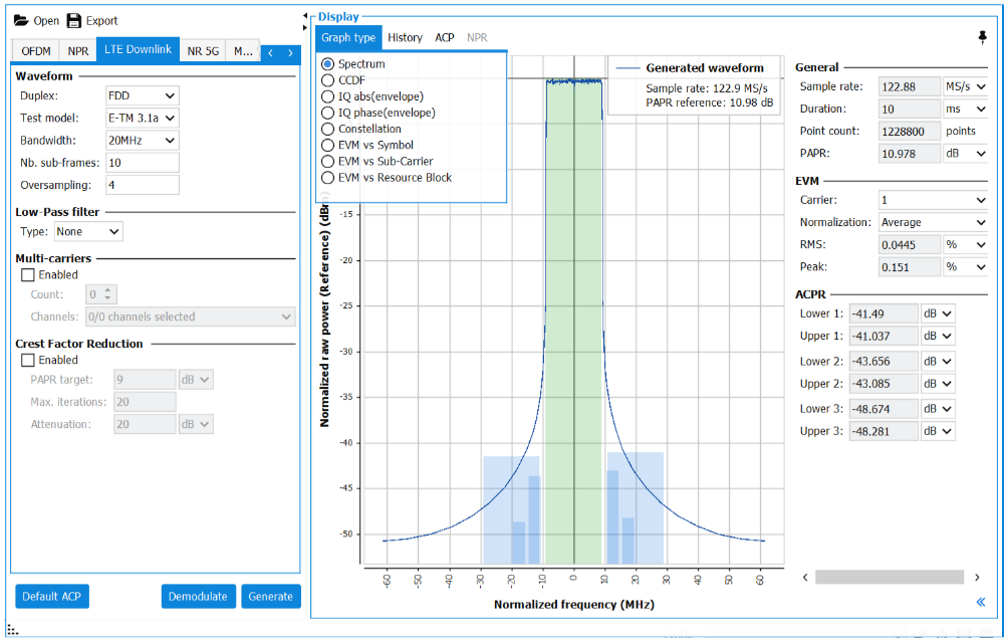
The new waveform generator WFG100-11 introduces the capabilities to generate and demodulate an LTE signal by analyzing the IQ signal in IQSTAR and calculating the EVM on symbols. This new module will manage directly the demodulation of the modulated signal in time domain, allowing a direct observation of the EVM constellation in IQSTAR. The new module also supports multi-carrier for LTE signals. The management of the modulation and demodulation of the LTE signal is performed in accordance with the 3GPP compliance standards.
The IQS100B-40 IQ signal measurements module is a prerequisite for the WFG100-11. The demodulation of the LTE signal in IQSTAR using this module only requires that the Vector Signal Analyser used for the test supports has an instantaneous bandwidth which covers at least the signal bandwidth. When ACP measurements and DPD analysis (IQS100B-41) are required, the bandwith of the VSA should be at least 4 to 5 tims the signal bandwith.
New traces like EVM vs sub-carrier and EVM vs resource clock were added to the visualisation module of IQS100B-40.
- New waveform generation and demodulation module for NR 5G signal (WFG100-12 Option)
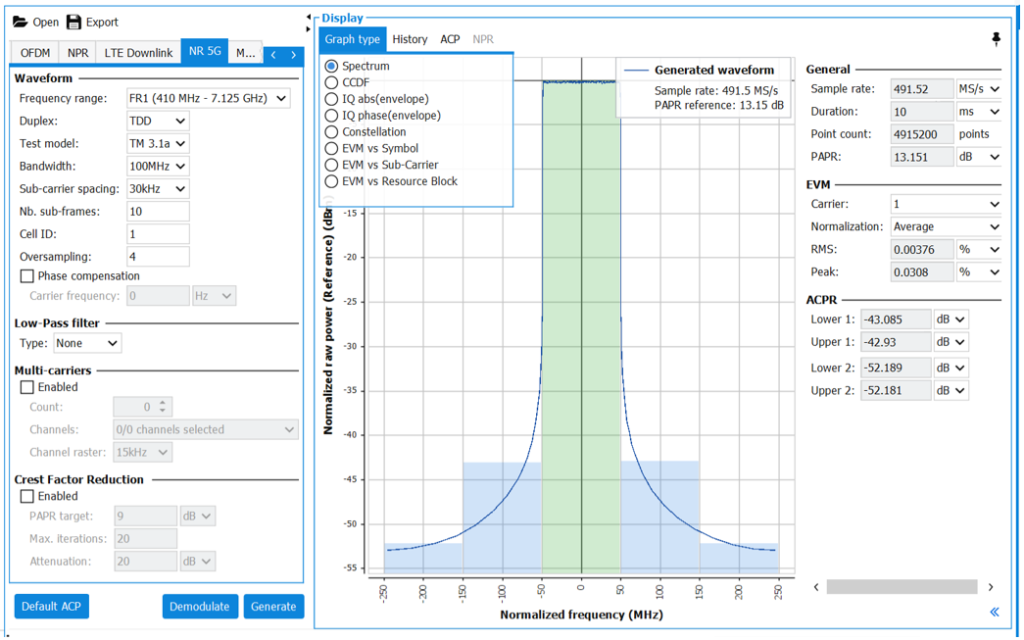
The new waveform generator WFG100-12 introduces the capabilities to generate and demodulate an NR 5G signal by analyzing the IQ signal in time domain and calculating the EVM on symbols. This new module manages the demodulation of the signal and enables a direct observation of the EVM constellation. The new module also supports multi-carrier for NR 5G signals. The management of the modulation and demodulation of the 5G NR signal is performed in accordance with the 3GPP compliance standards.
The WFG100-11 LTE is a pre-requisite for the WFG100-12 5G-NR Option. The demodulation of the 5G NR signal in IQSTAR using this module only requires that the Vector Signal Analyser used for the test supports has an instantaneous bandwidth which covers at least the signal bandwidth. When ACP measurements and DPD analysis (IQS100B-41) are required, the bandwith of the VSA should be at least 4 to 5 tims the signal bandwith.
New traces like EVM vs sub-carrier and EVM vs resource clock were added to the visualisation module of IQS100B-40.
- New measurement module IQS100B-21: Low-frequency behavioral model extraction bench control (3-tone signal)
This new module enables the control of a test bench based on a vector network analyzer, taking into account the management of 3-tone signals for the extraction of amplifier behavioral models managing the following effects:
– Bilateral effects caused by variable load impedance
– Low-frequency memory effects caused by the envelope of modulated signals
– High-frequency memory effects caused by the value of the carrier frequency.
Such a behavioral model is extracted using the “VISION” connected software platform, dedicated to circuit modeling and system simulation.
The IQSTAR IQS100B-21 module is used to supply measurement data to the VISION circuit modeling tool.
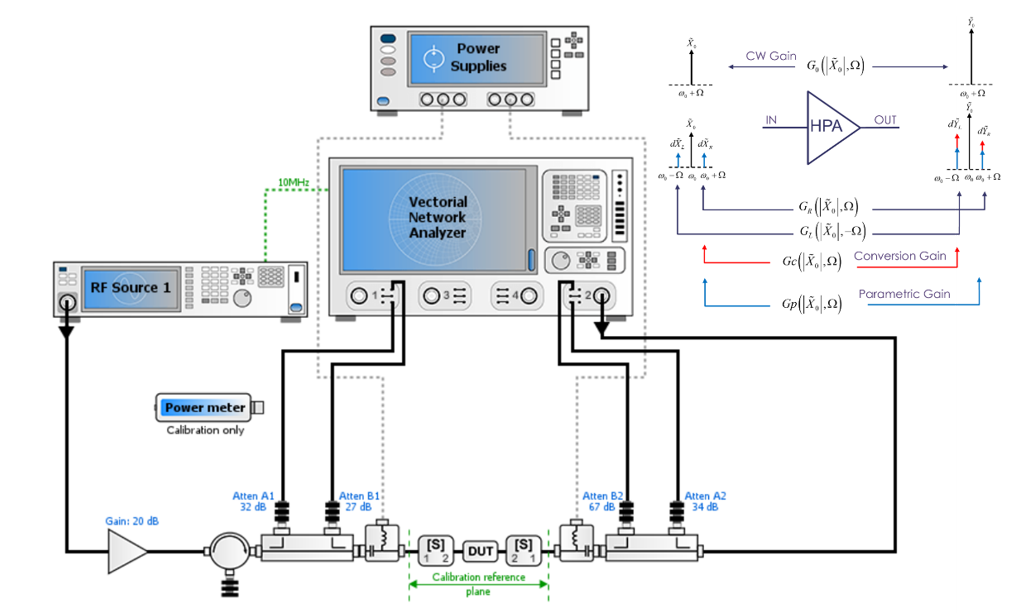
The 3-Tone Measurement module is an add-on requiring IQS100B-10 for scalar setups and IQS100B-11 for vector setups. It requires the use of a Vector Signal Generator (VSG) to generate and control the 3 tones and a Vector Network Analyzer (VNA) with Frequency Offset option. A new frequency sweep in the calibration menu was added to support this new module, allowing the generation of a list containing all central and side-tone frequencies based on the user’s specifications. Although this module shares the same general setting as the other measurement modules regarding device information, stop conditions, DC control and DC measurements, a dedicated sweep setting was developed to set the proper stimulus conditions, delta frequency sweep and side-tone levels.
Like any other measurement module, a dedicated live visualisation plug-in is provided with the 3-Tone module.
A particular attention was given to the seetings offered to manage the dynamic of the power tone versus the lateral probe tones in charge of the memory effects characterization.
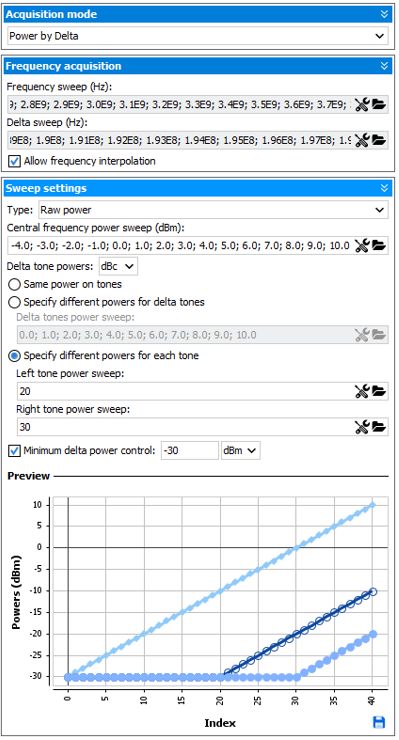
- New Waveform scripting functions
Scripting is an important module in IQSTAR. It allows the user to customize its characterization flow, taking advantage of all the built-in functionalities of the software. With every new release, new script functions are developed; this release is no exception. The list of the new scripting functions is as follows:
- Generation ‘wfmgen’ and demodulation ‘wfmdemod’ waveform
- Modulation: PSK/QAM ‘pskqam’, LTE ‘lte’, NR5G ‘nr5g’
- Filter: Raised Cosine ‘wfmrcfilter’ and Low Pass filter ‘wfmlowpassfilter’
- Multi-carrier: ‘wfmmulticarrier’
- Crest Factor Reduction: ‘wfmcfr
IQSTAR 1.6 Software General Improvements
The measurement speed is an important metric of the quality and efficiency of a setup and the software controlling it. Therefore, extra work was done to optimize the function calls, especially in the IV measurements. Indeed, dealing with power amplifiers suggests the control of multiple power suppliers to bias the amplifier stages and many more IV measurement instruments (Multimeters) to characterize the DC consumption. These operations represent a non-negligible part of the measurement time; therefore, optimization is key to increasing the overall measurement speed.
New traces were added to the IQ-measured data for LTE and 5G signal: EVM vs sub-carrier and EVM vs resource block. Moreover, new peak data were introduced with this latest version: Pout Peak, Pin Available Peak and GT peak (and all declined versions and DPD versions).
Multiple enhancements were added to the latest release to enhance the test engineer experience. Below is a list of improvements added to the IQSTAR 1.6 release.
- Added f0 as a variable in I/Q traces using the “Export” function.
- IV measurement: function calls optimization to improve measurement speed
- I/Q Measurement
- Added possibility to skip I/Q measurement sub-traces; not displayed in the real-time viewer (save memory usage) but available in I/Q viewer and Whiteboard
- Added possibility to skip EVM demodulation; not displayed in real-time viewer (faster measurement) but available in I/Q viewer and Whiteboard
- Removed trace duplication to save memory.
- Raw Power calibration
- Added possibility to change the step
- Added stop condition ‘Pin max’
- Viewer
- Real-Time viewer: added possibility to clear the viewer
- Added log for axis
- Added global data cache for all graphs of the same viewer to improve display speed
- Separates the Constellation trace into two traces: one without DPD and one with DPD
- Data Editor
- Added an information message on top of the data list to assist the user
The driver development for software like IQSTAR represents a non-negligible coding time for our software engineers. With new instruments come new measurement capabilities and features that need to be supported by our software. Our team is also putting all the necessary efforts into supporting our Instrument vendors’ partners by updating any driver when a new instrument firmware is released.
We thank our increasing number of customers worldwide for their feedback, allowing us to improve IQSTAR at every release. A more detailed list of all the new modules, features, enhancements, drivers, and bug fixes is available in the product manual of IQSTAR, available with the software installer.


